James Campbell National Wildlife Refuge, Oahu, Hawaii

The ponds, marshes, and fields north of Kahuku are among the most productive landscapes in Hawaii for the gamut of wetland and open country birds. A large chunk of this terrain has been consolidated for conservation as James Campbell National Wildlife Refuge. The area is known for breeding populations of Hawaiian Coot, “Hawaiian Gallinule”, and “Hawaiian Stilt” and substantial numbers and diversity of migratory waterfowl and shorebirds, consistently including Bristle-thighed Curlews, with occasional sightings of Hawaiian Duck. A fenced plot of coastal dunes has been established as a surrogate nesting colony for seabirds, including Laysan and Black-footed Albatrosses, Tristram’s Storm-Petrel, and Bonin Petrel.
Orientation
Directions
James Campbell National Wildlife Refuge is at the northern tip of Oahu, beside the town of Kahuku, about an hour and ten minutes’ drive (45 miles) north of downtown Honolulu, or an hour (40 miles) from Hawaii’s largest airport, Daniel K. Inouye International.
There are two approximately equidistant routes from Honolulu to Kahuku and the refuge, a western route and an eastern route. The western route passes beside Waialua and Turtle Bay Resort, and the eastern route follows the coast from Kaneohe to Laie.
Western Route. Starting from downtown Honolulu or the airport, take the main freeway, H1, northwest to Pearl City, then keep right to head north on the H2. Eight miles farther, take Exit 8 onto Highway 80. This soon becomes Highway 99, then at Waialua it becomes Highway 83, the Kamehameha Highway. About thirteen miles after Waialua it passes beside Turtle Bay, then two miles later it reaches the refuge.
Eastern Route. Starting from the airport, take the H1 to the H3 freeway, which crosses the Ko’olau Range to Kaneohe. Take the first Kaneohe exit (9) onto Highway 63 (the Likelike Highway) northbound, keeping right to exit again onto Highway 83 northbound. After about 25 miles you will reach Kahuku.
Attractions
Laie Point is about three miles south of Kahuku.
Birdfinding
James Campbell National Wildlife Refuge is a work-in-progress and seems likely to continue through transitional stages of development for many years before it eventually reaches a stable status quo. Meanwhile, any advice about conditions for visiting should be regarded as temporarily indicative, not certain, and an update on conditions should be sought while planning any future visit.
The refuge began in the mid-1970s with two parcels, the Ki’i Unit just north of Kahuku and the Punamano Unit about a mile and a half to the west—about halfway between the Ki’i Unit and Turtle Bay Resort. Between the two original parcels lies a large expanse of rectangular impoundments that have been used for aquacultural production, such as shrimp and tilapia, for many decades.
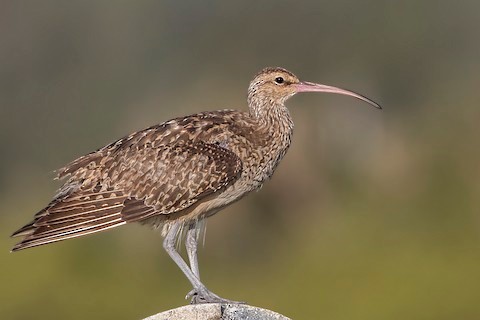
Bristle-thighed Curlew perched on a gravestone at the Kahuku Golf Course, showing the “bristles” on its thighs. © Bradley Hacker
As announced in 2010, all of the wetlands described above, plus much of the adjacent land spanning between the Kamehameha Highway and the shoreline, will comprise the fully realized James Campbell National Wildlife Refuge. The acquisition, restoration, and integration of the various parcels will require many years of carefully planned, deliberate actions. As a result, both the habitat and access to it can be expected to change, but the nature and timing of these future changes are difficult to predict.
Among the more predictably interesting and regularly accessible areas within and near the refuge, worth investigating while planning a visit, and described below, are: the Ki’i Ponds, the aquaculture zone along the Kamehameha Highway, the Kahuku Golf Course and old cemetery (just east of the refuge), and Turtle Bay Resort (west of the refuge).

Ki’i Ponds. The original core of James Campbell National Wildlife Refuge, the Ki’i Unit, is a cluster of impoundments in what is now the southeastern portion of the refuge property. Formerly settling ponds for process water from the nearby sugar mill, since the mid-1970s they have been managed primarily for waterfowl, shorebirds, and other wetland birds—most notably to support populations of the four wetland endemics: Hawaiian Duck, Hawaiian Coot, “Hawaiian Gallinule”, and “Hawaiian Stilt”.
The latter three are common and appear to maintain healthy populations in the area. The duck, in contrast, was widely believed to have vanished through hybridization with locally introduced Mallard stock—but apparently increasing sightings of ducks with characteristically Hawaiian features, starting around 2012 may indicate that it may be returning, perhaps through natural recolonization from Kauai.
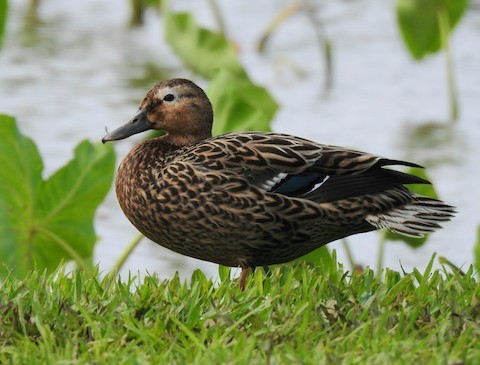
Sightings of apparently pure Hawaiian Ducks occur from time to time at James Campbell National Wildlife Refuge. © Joel Gilb
The Ki’i Ponds are also among the most productive places in Hawaii for numbers and diversity of migrant waterbirds, including both regular migrants and unusual vagrants. Bristle-thighed Curlew is consistently present from August to April, and a few first-year individuals may remain all summer instead of migrating to the Alaskan breeding grounds—they can also be found at the Kahuku Golf Course (see below). Noteworthy rarities have included Garganey (a few records), Tufted Duck, American Bittern, Snowy Egret, Marbled, Black-tailed and Bar-tailed Godwits, Sharp-tailed Sandpiper (most years), Common Snipe (at least once, in addition to the more-expected Wilson’s Snipe), and Gray-tailed Tattler (a few records).
This area is reached via a short road that intersects the Kamehameha Highway about a half-mile west of the traffic light in Kahuku. The road ends at a gate beside the Kahuku Wastewater Treatment Plant (a separate property that is surrounded by refuge land). The gate is usually locked, but if it happens to be open this is not necessarily an invitation to enter.
Conditions of access to the refuge have varied over the years. Unlike most other sites in Hawaii, the trend has generally favored more public access. Traditionally, the Ki’i Ponds area has been entirely closed during the main breeding season for Hawaiian Coot, “Hawaiian Gallinule”, and “Hawaiian Stilt”, which runs approximately from March through September. During the nonbreeding season, roughly October through February, visitor access has usually required advance planning and accompaniment by either refuge personnel or any of the local birdwatchers whose names have been added to a list of approved guides. In most years since 2010 or so, there have been regularly scheduled once- or twice-weekly tours from late October to late February. These conditions have evolved, however, and further changes should be expected, so it is important to inquire early about the applicable policy for any planned visit.
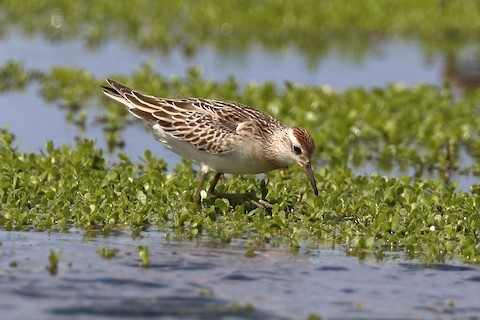
Juvenile Sharp-tailed Sandpiper, showing strong contrast between chestnut crown and whitish face, at James Campbell National Wildlife Refuge; November 18, 2016. © Sharif Uddin
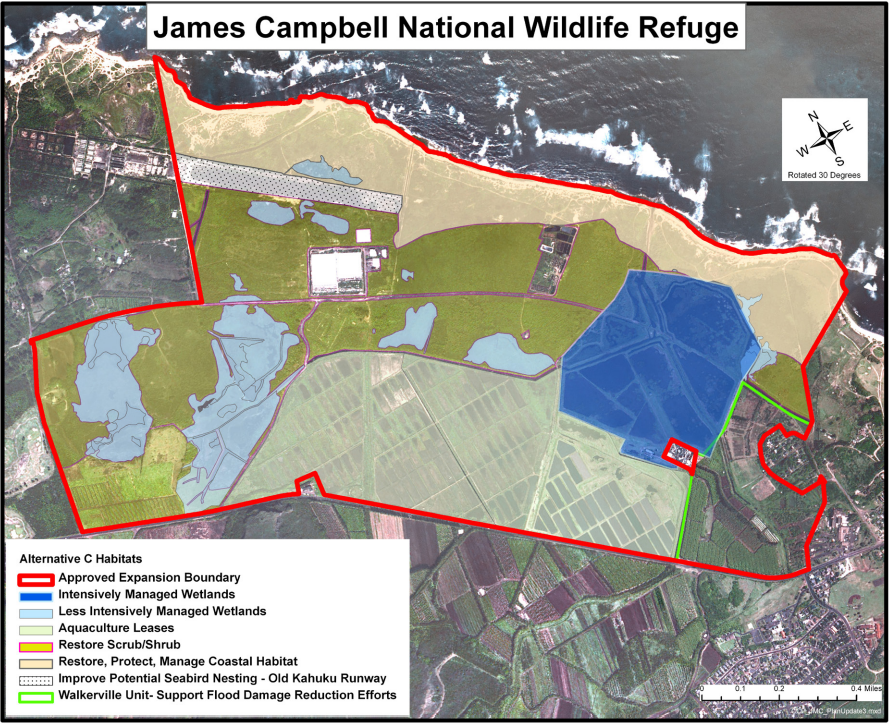
The Aquaculture Zone. For over a mile between Kahuku and Marconi Road, the Kamehameha Highway runs along the southern edge of a large expanse of rectangular impoundments. Historically, this area supported a robust aquaculture operation, the Amorient Aquafarm, which closed in the 1990s. The subsequent operators have managed the ponds less intensively, and following the transfer of ownership to the Fish & Wildlife Service it seems likely that the area will transition to management as wildlife habitat—perhaps in stages.
Since Amorient went out of business, most of the impoundments have been mostly dry most of the time. However, depending on the year and recent weather and management conditions, some of them hold varying amounts of water and provide habitat for the same types of waterfowl and shorebirds that are present at the Ki’i Ponds. Although the Kamehameha Highway is a fast and often busy road, observation of bird in the adjacent impoundments is relatively convenient because the highway has wide shoulders.
Over the years, many unusual vagrants have turned up, including most of the ones mentioned above, as well as Sora, Red-necked Stint, and Terek Sandpiper. (The same birds generally occur in both areas, but over the years, the aquacultural zone has been much more accessible than the Ki’i Ponds, and rarities were much more likely to be seen in the accessible areas.)

The “Hawaiian Gallinule” typically has more extensively black plumage, a larger red forehead shield, and redder leges than its continental relatives. © Noam Markus
While driving along the highway, watch for impoundments that have standing water or wet mud for shorebird foraging habitat. A favored approach at times has been to park in the lot behind Fumi’s Kahuku Shrimp restaurant, about a mile west of the road to the Ki’i Ponds, near the western end of the aquaculture zone. From the lot a walkable dyke road heads east into the old aquafarm and leads into the grid of branching dyke roads, some overgrown, some walkable. Japanese Bush-Warbler can often be found in brushy areas in this area, and elsewhere in the western portion of the refuge.
During the 1980s and ‘90s, a flock of Fulvous Whistling-Ducks inhabited the Amorient Aquafarm ponds, and bred on multiple occasions from 1984 to 1990, reaching a maximum of about 27 individuals. Others were found on Kauai, Molokai, and Maui, and for several years the generally accepted conclusion was that the species was colonizing Hawaii. However, subsequent research revealed that they likely escaped from captivity in a botanical garden on Kauai.
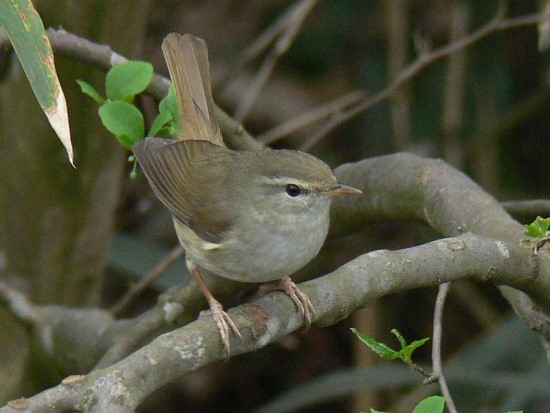
The plainly attired Japanese Bush-Warbler can often be found in brushy areas of James Campbell National Wildlife Refuge. © petitebouquet
Punamano Pond. At the far western end of the refuge is a natural, spring-fed pond that was somewhat accessible in the refuge’s early years, when it was the Punamano Unit, one of two original parcels. Public access to this area has generally been limited, and it has less of a proven tendency to produce unusual sightings—although this may be due more to lack of coverage than lack of birds.
When access to Punamano Pond has been possible, the recommended approach has been to turn north onto Marconi Road (the western boundary of the refuge), fork right at the first opportunity, and continue until reaching a gate and a dirt track that forks to the right. Park near the gate (without blocking it or the roadway) and walk along the righthand track. This track arrives at another gate and another dirt track that forks to the right. Take this righthand track for a short distance, until the pond comes into view.
Seabird Translocation. On the north side of the refuge, conservation biologists of the Fish & Wildlife Service and Pacific Rim Conservation constructed a predator-proof perimeter fence around 16 acres of coastal dunes to create a safe area for seabirds to nest. The project is aimed primarily at seabird populations of the Northwest Chain islands, which are expected to become increasingly susceptible to inundation by a rising sea level.
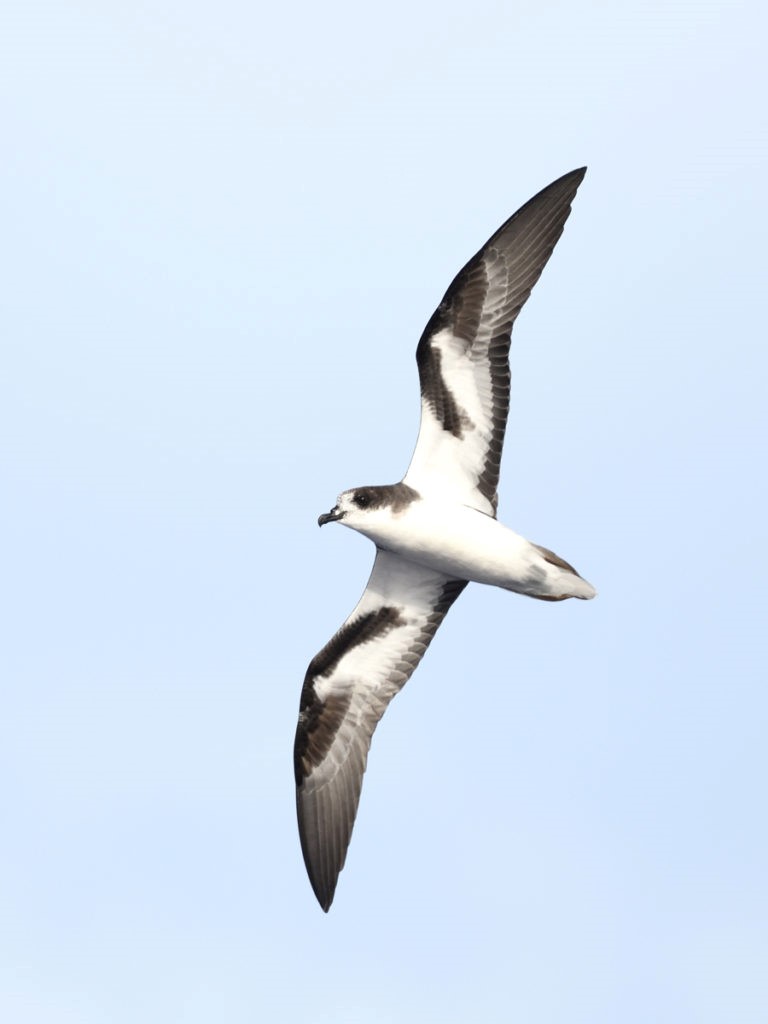
The first confirmed breeding record of Bonin Petrel was at James Campbell N.W.R. in 2021. © Hiroyuki & Shoko Tanoi
In 2017, Laysan Albatross became the first species to nest in the enclosure, and its numbers have grown in subsequent years—spreading to other parts of the refuge and nearby open areas, including the golf courses at Kahuku and Turtle Bay. In 2018, the team began translocating chicks of three other species from colonies in the Northwest Chain: Black-footed Albatross, Tristram’s Storm-Petrel, and Bonin Petrel. In 2021, Bonin Petrels were confirmed to have returned, nested, and successfully fledged young.
Kahuku Golf Course. When passing through Kahuku on the Kamehameha Highway, the main crossroads, with a traffic light, is Puuluana Street. To search for Bristle-thighed Curlews, turn north here, then fork right to reach the northern parking lot of the Kahuku Golf Course.

Laysan Albatross nests on and beside some Hawaiian golf courses, including those at Kahuku and Turtle Bay. © Donna Pomeroy
This public golf course is generally open to birdwatchers, but it’s best not to presume unlimited rights of access. Exercising due caution at all times, park in the lot and continue north on foot, following the dirt road along the western edge of the golf course. Soon this dirt road will cross the northernmost tip of the golf course, then a short distance farther it arrives at an old cemetery beside a sandy beach.
The graveyard is among the most convenient and reliable spots in the world to see Bristle-thighed Curlew. There are usually at least a few in the area at any time of year, and from August to April the local flock often swells to about 40, at times over 50. The curlews often roost on the gravestones.
The overgrown pastures and corrals west and north of the graveyard were traditionally accessible and frequently produced interesting sightings, but as they are incorporated into the refuge access is expected to be restricted. Laysan Albatross has nested on this golf course and northward on the recently acquired refuge properties.
Turtle Bay Resort. About a mile west of the refuge is the entrance road to the world-famous Turtle Bay Resort—perhaps best known as the setting of the 2008 movie Forgetting Sarah Marshall. The resort property comprises nearly 1,300 acres, and includes ornamental gardens, lawns, a golf course, and some natural areas. As at Kahuku Golf Course, Laysan Albatross has nested on this golf course and elsewhere on the resort property around Kahuku Point.
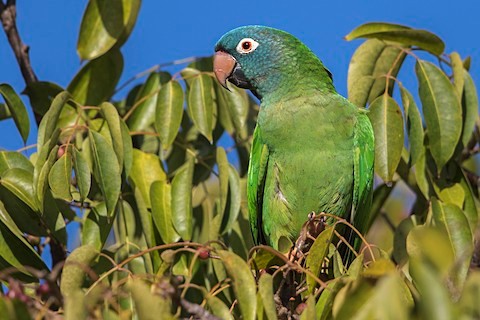
A flock of introduced Blue-crowned Parakeets can sometimes be found aroud Turtle Bay Resort. © Bradley Hacker
Most of the common introduced birds of Oahu occur on the grounds, and for many years also the state’s only known feral flock of Blue-crowned Parakeets—which has numbered up to about 25 individuals.
Kuilima Wastewater Treatment Plant. Across the Kamehameha Highway from Turtle Bay Resort, tucked away behind a densely wooded area down an anonymous gravel road, the resort’s wastewater treatment ponds have been a hotspot for ducks and shorebirds, often including vagrants such as Canvasback, Tufted Duck, and Ruff.
The four ponds are enclosed by a perimeter fence. Despite the fence, access was formerly uncontrolled, but this has changed, so the ponds are generally not accessible to visitors. Going forward, the policy could change again, so it may be worth a polite inquiry at Turtle Bay to request permission to enter.
Services
Accommodations
Just over a mile west of the refuge, Turtle Bay Resort is a popular but generally expensive vacation destination for many tourists. There are no other hotels in this part of Oahu. The nearest concentration of hotels is in Waikiki, which is a 50-mile drive south.
Food
Immediately adjacent to the refuge, along the Kamehameha Highway, are three popular shrimp options:
Fumi’s Kahuku Shrimp, (808) 232-8881
Romy’s Kahuku Prawns & Shrimp Hut, (808) 232-2202
Kahuku Shrimp & Thai Food Truck, (808) 554-6877
The town of Kahuku also has several restaurants. Those in Turtle Bay Resort are popular but pricey.
Notes
When to Visit
The refuge has historically remained closed to visitors from March into October. During its open season, access is usually limited to certain scheduled tour times: typically including Saturday mornings. As the refuge integrates its newly acquired properties and adds visitor infrastructure, access will presumably expand, but these measures are likely to proceed slowly over the course of many years. At the time of this writing (2021) any prospective visitor should research the refuge’s most recently announced visitation policies on its website.
Links